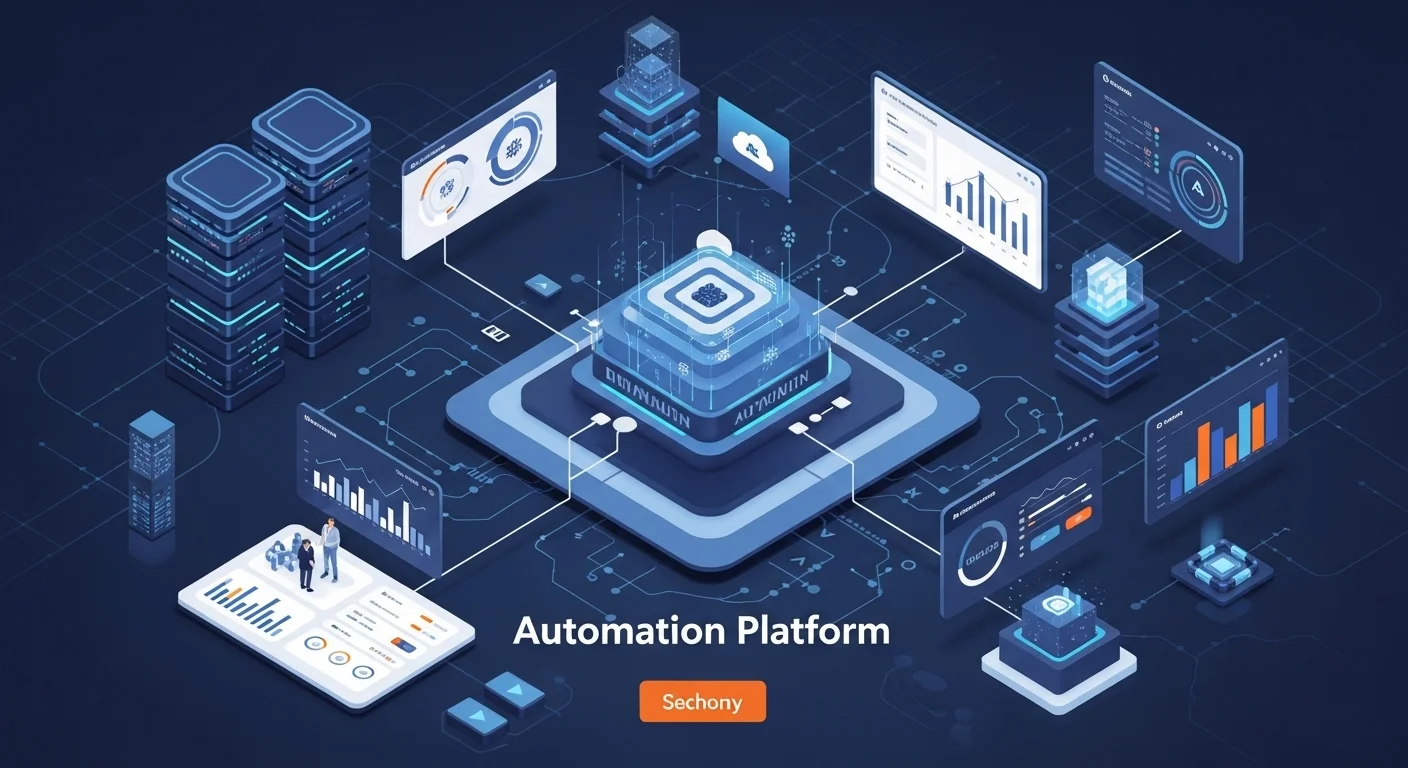What is an Automation Platform? A Guide from Business to Smart Homes

Executive Summary
I've spent years watching businesses and homeowners struggle with repetitive, soul-crushing tasks. The solution? An automation platform. It's not just about fancy software; it's about reclaiming your time and focus. For a business, this means slashing costs and errors, letting your team shine where it matters most. For your home, it means convenience and security you can actually feel. From simple workflows connecting your favorite apps to powerful AI that anticipates your needs, this technology is a game-changer. This article is my personal guide to understanding and using it. Let's dive in and see how automation can genuinely make your life easier.
Table of Contents
Table of Contents
- What is an Automation Platform and Why is it Essential?
- The Technology Behind the Magic
- How Businesses Win with Automation
- Bringing Automation Home: The Smart Home Revolution
- The Power of Open Source for Your Home
What is an Automation Platform and Why is it Essential in Technology?
In my line of work, I see a lot of companies and individuals chasing the next big thing. But if there's one piece of technology that's truly reshaping our world from the ground up, it's the automation platform. Let's break it down in simple terms. Think of an automation platform as your digital chief of staff, a software system designed to handle repetitive tasks and processes so you don't have to. It's the central command center that connects different apps and systems, making them work together seamlessly. The technology can be as simple as a rule—'if this happens, then do that'—or as complex as an Artificial Intelligence (AI) system that learns and adapts. The real goal here is to boost efficiency and accuracy, freeing up people from the mundane, clock-watching tasks. This allows us to focus on what humans do best: strategy, creativity, and problem-solving. In today's fast-paced world, this isn't a luxury; it's a fundamental requirement for growth and staying competitive. It's how you scale your operations without burning out your team.
The Technological Pillars of Automation Platforms
To really appreciate what these platforms can do, you have to look under the hood. There are a few key technologies that make it all happen. You'll often hear about Robotic Process Automation (RPA), which uses software 'bots' to mimic human clicks and keystrokes. I've seen it work wonders for businesses stuck with old software that doesn't have modern connection points (APIs). Then there's Business Process Management (BPM), which takes a bird's-eye view, looking at an entire workflow from start to finish to optimize it. It's less about a single task and more about redesigning the whole journey. And you can't talk about modern automation without mentioning Integration Platform as a Service (iPaaS). These are cloud-based tools that act like universal translators, connecting all your different cloud apps. But the real excitement, for me, is when AI and Machine Learning (ML) get involved. This is often called Intelligent Process Automation (IPA) or Hyperautomation. This is where the platform can read an email, understand its intent, make a decision, and learn from the result. It's automation that can 'think'.
Business Applications and Transformative Benefits
The impact of automation on business is staggering. I've worked with finance teams that have automated their entire invoicing and expense reporting, cutting down month-end closing from days to hours. Customer service departments use it for smart chatbots that provide instant answers 24/7, making customers happier. In HR, it streamlines everything from onboarding a new hire to running payroll. The benefits go far beyond just saving time. Here's what I've seen firsthand:
- Productivity Skyrockets: These systems work around the clock without coffee breaks, dramatically increasing output.
- Costs Come Down: You reduce labor costs for repetitive work and practically eliminate the expense of fixing human errors.
- Accuracy and Quality Improve: An automated process follows the rules perfectly, every single time. This consistency is a huge win for quality control.
- Scaling Becomes Easy: Need to handle double the orders next month? An automation platform can scale up instantly, without the headache of hiring and training.
- Smarter Decisions: These platforms generate a ton of data, giving leaders clear insights to make better strategic choices.
- Happier People (Employees and Customers): When you free your team from boring work, morale improves. And when service is fast and accurate, customers notice.
Bringing Automation Home: The Smart Home Revolution
This same powerful idea isn't just for corporations. It's transforming our homes. A home automation platform is the brain of a smart home, connecting your lights, thermostat, security cameras, and speakers into one cohesive system. The dream is to create a living space that responds to you. My own journey into this world started with a simple goal: stop fumbling for light switches in the dark. Now, my house prepares itself for the day when I wake up. Choosing the best platform for home automation is a personal decision. Big names like Amazon Alexa, Google Home, and Apple HomeKit are fantastic starting points because they're user-friendly and work with tons of devices. You can create 'routines,' like a 'Movie Night' scene that dims the lights and turns on the TV with one command. But for many tech lovers, including myself, the search for the best home automation platform leads down a more exciting path—one that offers ultimate control and privacy. This is where open-source solutions enter the picture, and they are truly a game-changer.
Exploring the World of Open Source Home Automation
For those of us who are a bit more hands-on or concerned about privacy, the quest for the best open source home automation platform is a rewarding one. Unlike commercial products, open-source platforms are built by a community of passionate developers. The code is open for anyone to see, which builds a huge amount of trust. More importantly, these platforms usually run locally in your own home. Your data doesn't get sent to a corporate cloud server. This is a huge win for privacy and means your home still works even if the internet goes down. The undisputed king in this arena is the Home Assistant open source home automation platform. I've been using it for years, and its power is simply unmatched. It supports thousands of devices from every brand you can imagine, letting you build automations that commercial systems can only dream of. For example, my Home Assistant checks my calendar and the morning traffic to decide the perfect time to wake me up. While it has a steeper learning curve, the result is a smart home that is truly yours, limited only by your imagination. For many enthusiasts, this makes it the definitive answer to finding the best platform for home automation. There are others, like OpenHAB and Domoticz, but the community and flexibility of Home Assistant are what make it my personal recommendation.

A Practical Guide to Automation Platforms for Business and Tech
Going beyond the basics, let's get into the practical side of making automation work for you. Whether you're running a company or building the ultimate smart home, understanding the methods, strategies, and available tools is key. This is the part where I share the 'how-to' knowledge I've gathered over the years, helping you navigate from planning to execution.
Technical Methods: The Engine Room of Automation
The magic of automation comes down to a few core technical methods. Think of APIs (Application Programming Interfaces) as a menu in a restaurant. They provide a clear, structured list of requests one software can make of another. When an automation platform has a 'native integration,' it means it knows how to order from that specific API menu. It's the cleanest and most reliable way to connect systems. Then there are Webhooks. If APIs are like calling a service to ask for updates, a webhook is like that service texting you the moment something happens. It's event-driven and incredibly efficient for real-time automations. For older systems without a proper API, we often turn to RPA (Robotic Process Automation). This is where a bot literally watches the screen and mimics your mouse clicks and typing. It's a fantastic solution for legacy software but can be more brittle than an API connection. Finally, the automations themselves are built using either a low-code/no-code visual builder with drag-and-drop blocks or by writing code. Low-code makes automation accessible to everyone, while pro-code options give developers the power to build anything they can imagine.
Business Techniques for Successful Automation Implementation
Buying the software is the easy part. Making it successful requires a smart plan. My first piece of advice to any business is always: Start with Discovery. You need to find the right processes to automate. The best candidates are repetitive, rule-based, and high-volume tasks that are prone to human error. I've used process mining tools that analyze system logs to show you exactly where the bottlenecks are—it's like an X-ray for your business operations. Once you have a list, prioritize based on return on investment (ROI). Next, I strongly recommend establishing a Center of Excellence (CoE). This sounds corporate, but it's just a core team from IT, business, and leadership that guides the strategy. They set the rules, ensure security, and champion the initiative. Always start with a Pilot Project. Pick one well-defined process, automate it, and prove the value. This success story will be your best tool for getting buy-in for more projects. From there, it's all about scaling up thoughtfully and continuously optimizing what you've built.
Comparative Analysis: Choosing the Right Platform
The market is crowded, so choosing the right platform is critical. In the business world, tools like Zapier and Make are fantastic iPaaS solutions for connecting cloud apps. I recommend them to small businesses all the time for their simplicity and huge library of connectors. For larger enterprises, the conversation shifts to hyperautomation platforms like UiPath or Automation Anywhere. These are heavy-duty systems that combine RPA, AI, and deep analytics for complex, company-wide operations. When we look at the home, the choice is just as personal. Finding your best home automation platform involves a trade-off:
- Compatibility: Amazon Alexa and Google Home are the champs of broad device support. Apple HomeKit is pickier, focusing on a secure, curated ecosystem. The best open source home automation platform, Home Assistant, wins on this front by supporting nearly everything, thanks to its amazing community.
- Ease of Use: If you want plug-and-play, the commercial platforms are for you. Their mobile apps are intuitive. The Home Assistant open source home automation platform, on the other hand, is a project. It requires a hands-on setup and has a learning curve.
- Power and Customization: This is where open source leaves the others behind. The automations I've built in Home Assistant are layers deep with conditions and logic that commercial platforms just can't handle. For raw power, open source is the undisputed winner.
- Privacy and Local Control: This is a deal-breaker for many. The big tech companies process your commands in the cloud. Home Assistant is built on a local-first principle. My data stays in my house, and my lights work even if my internet is out. This is why it's a top contender for the best platform for home automation for anyone who values privacy.
A Deeper Look at Home Assistant
Because I'm such a fan, I have to give a special mention to the Home Assistant open source home automation platform. It’s more than software; it's a vibrant ecosystem. Its strength lies in its thousands of 'integrations' that connect to almost any device or service you can think of. You can build automations with a simple visual editor or by writing powerful YAML code. The dashboard is completely customizable, so you can design an interface that's perfect for your family. And the community add-ons are incredible—I run things like network-wide ad-blocking and advanced data charting right from my Home Assistant. This is why, for those willing to invest a little time, it’s not just the best open source home automation platform—it’s arguably the best home automation platform, period. It lets you take powerful technology and make it personal, creative, and incredibly useful.

My Top Tips and Strategies for Mastering Automation
Getting an automation platform up and running is one thing. Truly mastering it to transform your business or perfect your smart home is another. It requires a strategic approach and a focus on best practices. Here are some of the most important tips and strategies I've learned over the years, designed to help you build automation that is secure, scalable, and genuinely improves your life.
Best Practices for All Automation Endeavors
These are the foundational rules I follow on any project, big or small, to ensure long-term success.
- Start Small, Win Fast, Iterate: I've seen too many projects fail because they tried to boil the ocean. Pick a simple, high-impact task for your first automation. Get that win. It builds momentum and gives you valuable lessons you can apply as you methodically expand.
- Document Everything: Before you can automate a process, you must understand it deeply. Map out every single step and exception. This documentation is your roadmap for building, troubleshooting, and improving the automation later on.
- Security and Governance First: Automation platforms can touch your most sensitive data. Use strong passwords, enable two-factor authentication, and be strict about who has access. For businesses, a formal governance model is non-negotiable. For home users, I always recommend putting smart devices on their own separate Wi-Fi network (VLAN) for extra security.
- Remember the Humans: The goal of automation is to empower people, not replace them. In business, this means communicating openly with your team and training them for more valuable roles. In the home, it means designing automations that are helpful, not confusing. A smart home should feel intuitive, not like a technical puzzle.
Advanced Strategies for Business Transformation
To move beyond simple task automation, businesses need to think bigger. Hyperautomation is a disciplined strategy where you aim to automate as much as possible across the entire organization. It’s about weaving a fabric of automation using a mix of tools like RPA, AI, and process mining. Another key strategy is Building an Automation Center of Excellence (CoE). This central team provides the vision, governance, and expertise to scale automation effectively and securely across all departments. Finally, the most exciting frontier is AI-Augmented Automation. This is where you embed machine learning into your workflows. I've helped clients use it to understand customer emails, process complex documents with computer vision, and even predict supply chain issues. This is where automation starts to 'think' and 'learn'.
Tips for Crafting the Ultimate Smart Home
For my fellow home automation enthusiasts, the journey is a creative process of continuous refinement. The choice of platform here is critical. If you crave power and privacy, the best open source home automation platform, like Home Assistant, is your best bet. The Home Assistant open source home automation platform provides a level of control that is second to none. Here’s my advice for building the best platform for home automation tailored to you:
- Build on a Solid Foundation: Your home network is everything. A reliable router and a wired connection for your automation hub are non-negotiable for stability.
- Think in Scenarios, Not Devices: Don't just automate a single light. Create experiences. My 'Good Morning' scene slowly brightens the lights, adjusts the heat, tells me my first appointment, and starts the coffee. A great platform lets you orchestrate these moments.
- Always Have a Manual Override: Technology fails. Make sure a light switch still works like a light switch. This is crucial for family and guest acceptance. Nothing is more frustrating than a smart home that feels dumb.
- Lean on the Community: If you choose an open-source platform like Home Assistant, the community is your superpower. Forums and videos have the answer to almost any problem you'll encounter. Someone has already blazed the trail for you.
The Future of Automation: AI, Convergence, and a Smarter World
This field is moving incredibly fast. The future is all about more intelligent and seamless automation. Generative AI is already allowing platforms to understand plain English commands and even help write the automation code for you. We're also seeing a huge trend toward human-machine collaboration, where collaborative robots ('cobots') work safely alongside people. The lines are also blurring between different types of automation. Soon, a single platform could manage your work tasks and then adjust your home's lighting and temperature based on your commute time. The journey is heading towards a world where technology anticipates our needs and works quietly in the background to make our professional and personal lives more productive and enjoyable. For those interested in the corporate side, Gartner's research on Hyperautomation is an excellent resource on where the industry is headed.
Expert Reviews & Testimonials
Sarah Johnson, Business Owner ⭐⭐⭐⭐
As a small business owner, I was drowning in admin. This article gave me a clear starting point. The section on prioritizing tasks for automation was a real eye-opener. A bit more on budget-friendly tools would be great, but it's a solid 4 stars.
Mike Chen, IT Consultant ⭐⭐⭐⭐⭐
I'm an IT consultant, and I've seen clients struggle with this. This is one of the best overviews I've read. It nails the difference between RPA and iPaaS without getting too technical. I'm already sharing it with my team.
Emma Davis, Tech Enthusiast ⭐⭐⭐⭐⭐
Finally! An article that connects enterprise automation with the smart home hobbyist world. The deep dive on Home Assistant is spot on—it perfectly captures why it's such a beloved platform. This is a must-read for anyone serious about automation.



